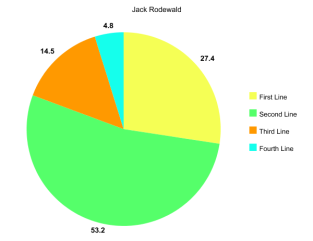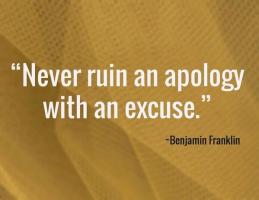This is the final installment of my season review. Along with a look at rookie performances in Belleville, I was going to end this with thoughts on what should be done with the roster along with what I think will actually happen to the roster, but that doesn’t fits thematically and this is long as it is, so I’ll do that separately. As I’ve done previously I’ll arrange players from oldest to youngest–my pre-season projections are noted in brackets where applicable–comments about the attributes of players who appeared briefly should be taken with a grain of salt.
Jordan Murray DL (1992; CIS FA 2017 AHL-deal)
Previous season (16-17): CIS 30-14-26-40 (1.33)
2017-18: 58-8-15-23 (0.40)
With or Without You record: 21-34-3/8-8-2
Shots/hands: good/average
Hockey IQ: average
Skating: average
Powerplay: 3rd in usage, 6th in effectiveness
Penalty Kill: limited usage (45 shifts), where he was not that effective
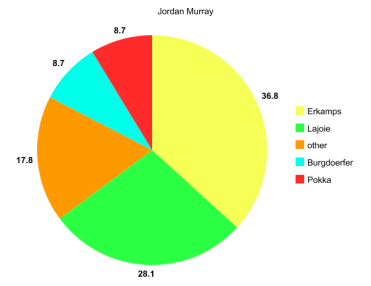
The org is very fond of Murray, a converted-forward who plays a gritty style. He’s a clumsy defensemen–not great with coverage and struggles with the transition game (especially on the PP where he was very indecisive). He’s at his best in the offensive zone, largely a shooter rather than distributor. Because of his questionable decision-making there’s no hope for him at the next level, but he could evolve into a decent AHL-blueliner. I think we saw far too much of him this season.
Boston Leier LW (1993; CIS FA 2018 AHL-deal)
2017-18: CIS 27-15-24-39 (1.44)
2017-18: 8-4-2-6 (0.75)
With You record: 4-4-0
Shots/hands: good/average
Hockey IQ: average
Skating: good
Powerplay: only played 11 shifts (no impact)
Penalty Kill: played just a few shifts (7) where he wasn’t very effective
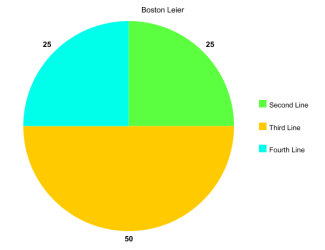
Another Canadian University signing, he was invisible to start with, but prior to returning to school started showing his offensive flair. In limited viewings he came across as primarily a shooter, but it’s hard to say more than that because of his varied usage. There’s potential here, however (at least at this level), so I was happy with the signing.
Ryan Scarfo C (1994; NCAA FA 2018 AHL-deal)
2017-18: NCAA 38-20-16-36 (0.95)
2017-18: 13-2-2-4 (0.31)
With You record: 6-7-0
Shots/hands: average
Hockey IQ: average
Skating: good
Powerplay: played quite a bit (38 shifts) where he wasn’t very effective
Penalty Kill: limited usage (19 shifts) with reasonable effectiveness
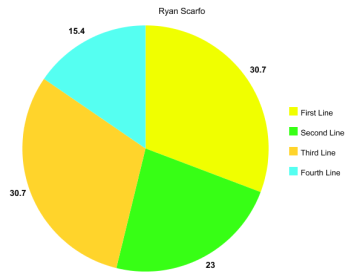
I wasn’t impressed by him throughout his lengthy debut. Nothing stood out, good or bad, and were it not for a final flurry of points (3-2-1-3) he’d be a complete disaster. As an older college player I expect a lot more so I’m not sure what the BSens achieved by signing him (I worry about him being another Garrett Thompson).
Andrew Sturtz RW (1994; NCAA FA 2018)
2017-18: NCAA 37-14-26-40 (1.08)
2017-18: 6-1-2-3 (0.50)
With record: 3-3-0
Shots/hands: average
Hockey IQ: average
Skating: good
Powerplay: limited usage (9 shifts) with decent effectiveness
Penalty Kill: barely used (4 shifts)
Lines: spent half on the first, then once on the other three
For a guy known for offense Kleinendorst was reluctant to use him on the PP for whatever reason. He showed some flashes of skill, but who he played with and various ice-time limitations make it hard to truly evaluate him purely on his time with the BSens (as such, I don’t have a strong opinion on him getting an ELC).
Marcus Hogberg G (1994; 3-78/13)
Previous season (16-17): SHL 19-14-0 .932 1.89
2017-18: 6-12-0 .899 3.27
Athleticism: average
Technique: average
Goal support: 2.44 (team average 2.55)
Average shots against: 30.66 (season average 33.01)
It was a crazy year for Hogberg, who had fantastic numbers in Sweden, but was all over the place in Belleville. I mentioned in Part One that his save percentage is essentially the same as Danny Taylor and Andrew Hammond (with Filip Gustavsson likely headed towards the same number given time), so his inferior win-loss record is in part due to bad luck (both Hammond and Gustavsson received much better goal-support, although no one received less help than Chris Driedger). The BSens have a terrible blueline and that didn’t help anyone between the pipes. Beyond the numbers what stood out most was technique: Hogberg was erratic all season in his positioning–often appearing too small or else being slightly out of position. He’s athletic for a big man, but a lot of his success is down to technique and there he clearly needs better support.
Christian Jaros DR (1996; 5-139/15)
Previous season (16-17): SHL 36-5-8-13 (0.36)
2017-18: 44-3-13-16 (0.36) [0.25]
With or Without You record: 20-21-3/9-21-2
Shots/hands: excellent/good
Hockey IQ: good
Skating: good
Powerplay: 4th in usage, 3rd in effectiveness
Penalty Kill: 5th in usage, 7th in effectiveness
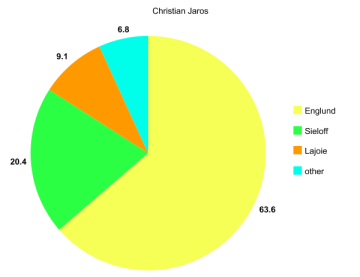
I was really happy with what I saw from Jaros this season (his with or without you numbers are spectacular). Injury-struggles and coaching eccentricity restricted what he could show, but there was a lot to like. He’s got a huge, NHL-caliber shot from the blueline, is a decent passer and can carry the puck up the ice. He still needs some work defensively, although many of his struggles were due to inadequate partners (ahem, Englund). He was underdeployed on the powerplay (as explored in Part Two) and I can only wonder what we might see with proper coaching. Otherwise he showed smart aggression (no running around for big hits) and I really have no complaints–he was better than I expected (the org gave the impression he was another Englund) and I look forward to more.
Colin White C (1997; 1-21/15)
Previous season (16-17): NCAA 35-16-17-33 (0.94)
2017-18: 47-11-16-27 (0.57) [0.70]
With or Without You record: 18-25-4/11-17-1
Shots/hands: good
Hockey IQ: excellent
Skating: excellent
Powerplay: 3rd in usage, 1st in effectiveness
Penalty Kill: 6th in usage, 2nd in effectiveness

A smart, talented player who I expected more offense from. Despite irrationally being put on the third line for more than a quarter of the season, and despite sometimes having offensively anemic teammates, you expect him to do more at this level. That said, it was an awful season for the BSens, so I don’t see the numbers as a negative indicator, other than raising the question that was open when he was drafted which is: how much can he produce at the NHL-level? In the AHL, however, if he comes back, he’s a tremendous asset.
Thomas Chabot DR (1997; 1-18/15)
Previous season (16-17): QMJHL 34-10-35-45 (1.28)
2017-18: 13-2-5-7 (0.54) [0.61]
With or Without You record: 4-8-1/25-34-4
Shots/hands: good/excellent
Hockey IQ: excellent
Skating: excellent
Powerplay: 1st in usage, 5th in effectiveness
Penalty Kill: limited usage (19 shifts), but pretty effective
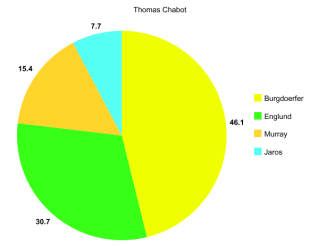
Saddled as he was with largely useless partners, it was fun seeing him play (however briefly). His first five AHL-games in particular, prior to his injury, were fantastic–he was dominant and drove the play–his skill well above the level of the league. After the injury he took a half-step back, but there’s no question he’ll never play in Belleville again–he’s simply too good. Ottawa fans can simply watch and enjoy.
Filip Chlapik C (1997; 2-48/15)
Previous season (16-17): 57-34-57-91 (1.59)
2017-18: 52-11-21-32 (0.62) [0.59]
With or Without You record: 19-29-4/10-13-1
Shots/hands: average/excellent
Hockey IQ: excellent
Skating: good
Powerplay: 4th in usage, 4th in effectiveness
Penalty Kill: n/a
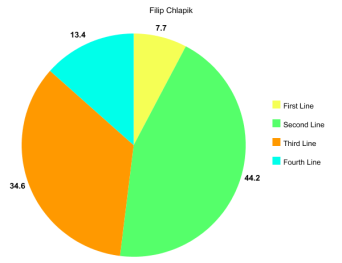
I had fears coming into the season that Chlapik’s numbers in the QMJHL were both inflated by the league as well as by Pittsburgh teammate Daniel Sprong (who was dominant with Wilkes-Barre this year, 65-32-33-65). Although he doesn’t have blazing speed or a big shot, Chlapik is a cerebral player with strong possession skills. Often handicapped by talentless teammates (his usage remains the most ridiculous of the season–grinding out a team leading point total while spending half the season in the bottom-six is incredible). How well his skills translate to the NHL I’m less sure of–he likes to hang onto the puck and that’s harder to do at that level. If he comes back to Belleville next season, however, I expect his numbers to improve by a large measure.
Maxime Lajoie DL (1997; 5-133/16)
Previous season (16-17): WHL 68-7-35-42 (0.61)
2017-18: 56-1-14-15 (0.27) [0.38]
With or Without You record: 21-31-3/8-11-2
Shots/hands: average/good
Hockey IQ: good
Skating: average
Powerplay: 5th in usage, 7th in effectiveness
Penalty Kill: limited usage (47 shifts), but very effective

A smart player with good puck skills, I think skating might keep him from reaching the next level–he’s not fast and I don’t think he can get away with that in the NHL. At the AHL-level he spent much of the season stuck with inadequate partners who limited his offensive capabilities. His smarts help him defensively, although I don’t think he’s someone who suits a heavy PK-rotation. He compliments big shooters on the PP because he’s a pass-first player (he also doesn’t have a big shot). He’s very young so there’s lot’s of room for growth (assuming coaches give him that opportunity).
Filip Gustavsson G (1998; 2-55/16 Pit; trade)
2017-18: SHL 9-11-0 .918 2.07
2017-18: 2-4-0 .912 3.01
Athleticism: good
Technique: good
Goal support: 3.14 (team average 2.55)
Average shots against: 32.5 (season average 33.01)
Small sample size can do a lot for first impressions as Sens fans are over the moon about the young Swede (eg). He did play well, but it was clear that as time went on his numbers were starting to regress to the mean, making it hard to compare him to the other goaltenders as he wasn’t put in front of the same nightmare for a full season. What we saw was a very calm goaltender with good technique–athletics were rarely required due to positioning. He was the beneficiary of the best goal-support among BSen netminders, which doesn’t hurt. I share some of the optimism about him going forward, but I’m not sure he’ll thrive beneath the conservatism of a Kleinendorst-regime (or a similar coach who replaces him), who would always favour whatever veteran he’s paired with–I’m readying myself for yet another three-headed monster in goal for 2018-19.
Parker Kelly C/RW (1999; CHL FA 2018)
2017-18: WHL 69-29-30-59 (0.85)
2017-18: 5-1-0-1 (0.20)
With You record: 3-2-0
Shots/hands: good/average
Hockey IQ: average
Skating: excellent
Powerplay: barely used (5 shifts)
Penalty Kill: effective in his limited appearances (16 shifts)
Lines: mostly the second line with one on the third
Such brief exposure isn’t a very representative sample. I liked his speed and the structure of his game, although it’s hard to judge his offensive potential at this level without more games. Nothing negative to put here, just hard to make a firm assessment.
Alex Formenton LW (1999; 2-47/17)
2017-18: OHL 48-29-19-48 (1.00)
2017-18: 2-0-0-0 (0.00)
With You record: 1-1-0
Shots/hands: good
Hockey IQ: excellent
Skating: excellent
Powerplay: limited use (5 shifts)
Penalty Kill: ibid (2 shifts)
Lines: he was on the first in the two games he played
Was hurt early in his second game, so it’s not fair to say anything about him really, other than I liked what little I saw. Because of how the org views him he didn’t get jerked around by Kleinendorst and saw regular rotation 5-on-5 and on special teams.
This article is written by Peter Levi (@eyeonthesens)


